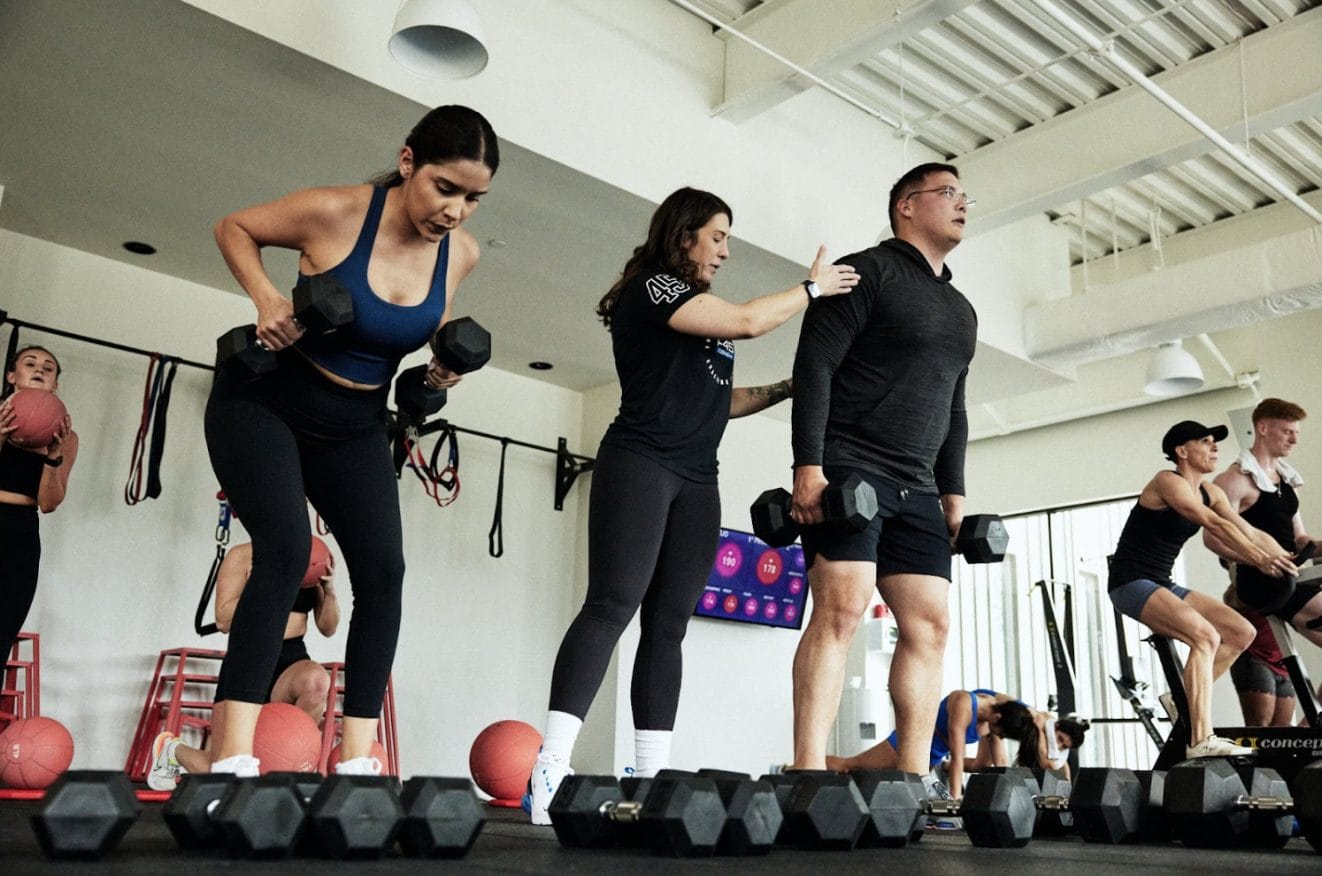For those who want to embark on a fitness or weight loss journey, they tend to consider two types of training: HIIT or cardio. As one of the most well-known forms of exercise, when we think of cardio (cardiovascular) training, we usually imagine someone running. Even though running is a form of cardio exercise, cardio training can be a lot more dynamic and engaging than your usual jog. On the other hand, HIIT (high-intensity interval training) has increased in popularity over the last decade and has become a valuable addition or alternative to traditional cardio. Both types of training can be effective, so if you’re weighing up between HIIT vs cardio or a mix of both, the experts at F45 are here to help you find the optimal training plan.
What is HIIT?
As the name implies, HIIT involves short and intense bursts of exercise, followed by regular intervals which act as rest periods. Depending on the length of a HIIT workout, rest periods usually range between 10 seconds to 1 minute. One of the main HIIT benefits is weight loss; whole-body HIIT circuit training encourages the body to burn more fat and build lean muscle mass.¹
In a beginner HIIT workout, a set may include 40 seconds of performing an exercise with a 20-second rest in between.
- Burpees (40s)
- Rest (20s)
- Jumping jacks (40s)
- Rest (20s)
- Push ups (40s)
- Rest (20s)
HIIT training engages our anaerobic system, which is the system we use for explosive short-term movements. The anaerobic system uses energy stored in our muscles and doesn’t need oxygen to function. We use our anaerobic system when we are performing intense physical activity for short duration². This is why rest intervals are necessary in HIIT because we may not be taking in oxygen while performing a HIIT exercise. HIIT training benefits are implemented in various F45 workouts to quickly burn calories and efficiently challenge your body.
In short, HIIT workouts are:
- high intensity
- dynamic exercises
- anaerobic
- short (usually 10-30 minutes)
What is traditional cardio training?
Cardio training is any rhythmic activity that raises your heart rate. Cardio training usually has little variation and involves repeating one action for a sustained amount of time. Historically, cardio has been the popular choice for weight loss management and muscle development. Today, people have the option of HIIT or cardio, or a combination of both.
Common examples of cardio training are:
- running
- walking
- cycling
- swimming
Cardio training engages our aerobic system, which uses oxygen to produce energy. This is why cardio exercise usually involves regular and steady breathing.
In short, cardio workouts are:
- low-moderate intensity
- typically involve one exercise
- aerobic
- long (usually 30 minutes or more)
HIIT vs cardio: the benefits
There are various physical and mental benefits of both cardio and HIIT training. So, are HIIT workouts better than cardio? Well, the answer isn’t that simple – what works for one person may not be right for you. The fitness experts at F45 have advanced knowledge of HIIT vs cardio to help you maximise your results. Let’s dive in to help you find the best training type for your fitness goals.
What are HIIT benefits?
If you’ve found it difficult to sustain a workout regime that relies solely on traditional cardio, HIIT might be the type of training that helps you smash your fitness goals and keep you engaged. HIIT benefits include:
- Higher calorie burns: HIIT may burn up to 30% more calories than other types of exercise.²
- Resting fat loss: Some research has found that HIIT increased people’s metabolic rate after working out, helping to burn more calories while resting.³
- Improved muscle mass: HIIT can increase your muscle mass, especially if you’re new to working out.4 The muscles that develop the most are usually those in your glutes and thighs, as they’re commonly used for explosive movements.
- Other health benefits: HIIT can improve your heart rate, blood pressure5 , blood sugar levels and your ability to consume oxygen.6 HIIT workouts may also boost your mental health and overall wellness since it helps reduce stress.
- Shorter workouts: When comparing HIIT vs cardio, one key difference is workout time. If you want faster results in less time, we strongly encourage implementing HIIT exercises into your workout routine.
What are traditional cardio benefits?
Cardio exercise has been empowering people since the beginning of time. It has a number of health advantages, is simple to start, doesn’t need to include equipment, and can performed at a pace that’s comfortable for you. Cardio benefits include:
- You can adjust for your needs: While a lot of cardio exercises can be high impact (like running), you can also choose low impact exercises that are easier on your joints (like swimming). This makes it easier to adapt to all fitness levels and abilities.
- Fast recovery: Because cardio is usually less intense on the body than HIIT, we can generally recover quicker and do more cardio sessions without muscle overuse.
- Improved endurance: Cardio strengthens the heart, lungs and muscles, improving how efficiently we circulate oxygen. This allows us to train for longer and experience less fatigue.7
- Other health benefits: Cardio is known for reducing stress, boosting mood, lowering blood pressure and improving sleep. These benefits are best experienced when reinforced with healthy nutrition.
Which training should you choose: HIIT or cardio?
If you’re not sure which training type is best for you, we’ve outlined some key pointers to guide you in your decision between HIIT or cardio.
HIIT training is recommended if:
- Your main goal is quick weight loss
- You have limited time to exercise
- You enjoy the burn of intense workouts
- You want more variation than traditional cardio
- You want to learn dynamic workout movements
Cardio training is recommended if:
- You want more control over the intensity of your workout
- Your goal is gradual weight loss
- You’re new to fitness and are looking for a simple workout routine
- You’re training for endurance activities such as a marathon
Remember, neither training type is better than the other, it’s about weighing up HIIT vs cardio and matching them with your preferences to build a sustainable fitness routine. At F45, we offer a new standard of cardio workouts, combining cardio and HIIT movements for outstanding results.
Enjoy learning about HIIT vs cardio training? Next, explore the connection between sleep and exercise.
1 https://www.ncbi.nlm.nih.gov/pmc/articles/PMC10054577/
2 https://www.ncbi.nlm.nih.gov/pmc/articles/PMC5329739/
3 https://pubmed.ncbi.nlm.nih.gov/25162652/
4 https://pubmed.ncbi.nlm.nih.gov/27747847/
5 https://pubmed.ncbi.nlm.nih.gov/33512698/
6 https://pubmed.ncbi.nlm.nih.gov/26918846/
7 https://pubmed.ncbi.nlm.nih.gov/27368057/















